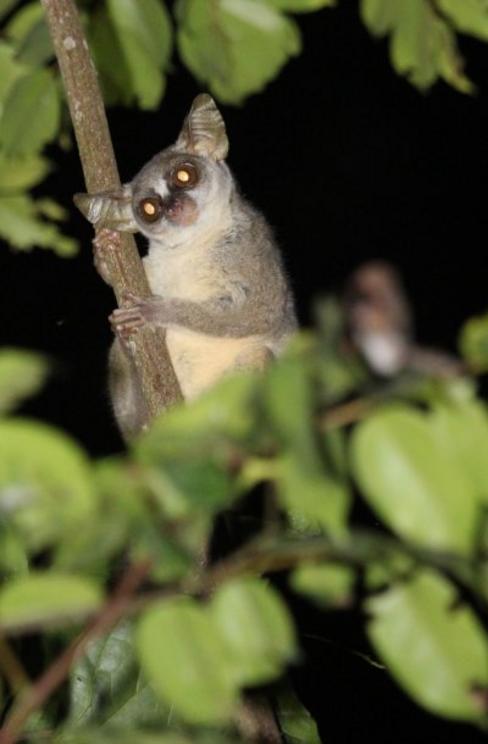This new primate is a ‘giant’ among tiny bush babies
The newly described Angolan dwarf galago is nearly three times the size of other known dwarf galagos.
- The Angolan dwarf galago is about 17 to 20 centimeters in length (with an additional 17 to 24 centimeters long tail).
- It has a very distinctive call: a loud chirping crescendo of longer notes, followed by a fading twitter.
- Scientists have named the new species Galagoides kumbirensis after the Kumbira forest it was first observed in.

In the forests of north-western Angola, scientists have discovered a new species of primate — a greyish-brown dwarf galago or bushbaby, larger than all previously known dwarf galagos.
The newly described Angolan dwarf galago, named after the only country it is known to occur in, has big eyes with a distinctive white stripe between them, a long furry tail, and a slightly up-turned muzzle that merges into the dark eye-rings. Like other galagos, it is a nocturnal primate, preferring to live on tree tops.
The Angolan dwarf galago is about 17 to 20 centimeters in length (with an additional 17 to 24 centimeters long tail), nearly three times the size of other known dwarf galagos, scientists report in a new study published in the American Journal of Physical Anthropology. This makes it a “giant among dwarfs”, the researchers say.

Another trait that sets the new bushbaby apart from its relatives is its distinctive call: a loud chirping crescendo of longer notes, followed by a fading twitter. In fact, the call and appearance of the Angolan dwarf galago is so different from that of other known dwarf galagos, that the researchers say that they felt no need to verify its status genetically.
“When we first encountered the new species in Kumbira Forest in north-western Angola, we heard a distinctive ‘crescendo’ call similar to that of a tiny galago, but upon seeing one, we were struck by its remarkably large size,” lead author Magdalena Svensson from Oxford Brookes University said in a statement.“Until now, call types have been the most reliable way to distinguish galago species, and to find one that did not match what we expected was very exciting.”
In September 2013, Svensson and her colleagues observed 36 live individuals of the new species of dwarf galago in three sites in north-west Angola: Kumbira forest, Bimbe, Northern Scarp Forest. The team took photographs of the individuals, recorded their calls and noted their behavior, and compared their measurements with museum specimens of other galagos. Their analysis showed that the dwarf galago was indeed a new species.
 Rondo Dwarf Galago
Rondo Dwarf Galago
“This new Galago species is a very exciting discovery,” Russell Mittermeier of Conservation International said in the statement. “It is only the fifth new primate described from the African mainland since 2000 and only the second species of galago. What is more, it is from Angola, where there has been very little primate research to date.”
The scientists have named the new species Galagoides kumbirensis after the Kumbira forest it was first observed in. This understudied forest, known for its bird and plant diversity that includes several endemic and globally threatened species, is under threat from commercial logging and deforestation for farming and charcoal production. According to data from the University of Maryland visualized on Global Forest Watch, the area comprising Kumbira forest lost nearly 5 percent of its tree cover between 2001 and 2014.
The researchers hope that naming the new primate after this forest will draw attention to the area.
Kumbira forest is an isolated tract of dense forest in west-central Angola. However, Global Forest Watch shows it has not been immune to recent tree cover loss.

Given that the Angolan dwarf galago’s habitat is in decline and all known locations fall outside protected areas, the researchers recommend listing the species as Vulnerable in the IUCN Red List.
The team also believes that many more new species of primates and mammals remain to be discovered in Africa.

“It is no surprise to find not only a new species, but one with such distinctive body proportions, making it really a whole new kind of bushbaby,” said co-author Anna Nekaris, Professor at Oxford Brookes University. “We have been seeing this emerging diversity in Madagascar over the last two decades, yet the nocturnal species of Africa and Asia remain still comparatively unexplored and this giant dwarf galago is just the tip of the iceberg in new discoveries.”

